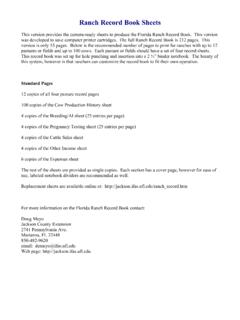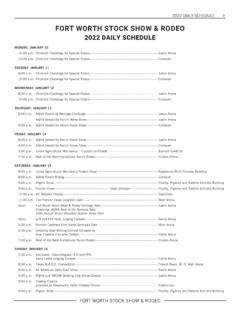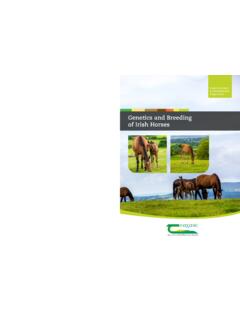Transcription of Livestock Judging Manual
1 South Dakota State University Livestock Judging Manual Designed for 4-H Seniors and Experienced Judges Second Edition South Dakota State University College of Agricultural & Biological Sciences Department of Animal & Range Sciences SOUTH DAKOTA Livestock Judging Manual Oral Reasons .. 20 2 20 20 2 Livestock Judging 22 A Class of 3 Words or Phrases to 23 Placing 4 Voice 24 Develop a System for 4 Reasons Parts of the Animal .. 4 Note 25 External Parts of Beef Cattle .. 5 Example Oral 26 29 External Parts of 6 External Parts of 7 Selection Beef 8 Ideal breeding Heifer.
2 9 Ideal Market Steer .. 12 Hog 13 Ideal Market 14 Ideal breeding 16 17 Ideal breeding 18 Ideal Market Lamb .. 19 Author: Kelly Bruns Instructor, Livestock Judging Team Coach Department of Animal & Range Sciences South Dakota State University, Brookings. Acknowledgments: The author is grateful to his secretaries Betty Knutsen and Rozanne McGrath for their untiring aid in assembling this Manual and making it a reality. Without their help, this Manual could not have been published.
3 The illustrations are the fine work of Kara Lamport, Hecla, SD and Dr. Roger Hunsley, past graduate of South Dakota State University and Secretary of the American Shorthorn Association. Utilizing Livestock Performance Data .36 Beef Performance 36 Sheep Performance 37 Swine Performance 38 Example Performance 39 Live Animal 42 Beef Cattle 42 USDA Yield 43 USDA Quality 45 Swine 48 USDA Quality 48 Lamb 50 51 Preface: The author prepared this Manual for anyone who is confronted with learning the fundamentals of Livestock Judging .
4 The author is cognizant of the fact that portions of this Manual will soon become outdated as selection standards change. The author realizes that some coaches may not agree with some of the suggestions made in this Manual . This is only natural, and it is important for students to follow the advice of their coach to remain successful. Edition: This edition is designed for students who have experience in Livestock evaluation and would like further education on reasons. Edition 1 1997. Edition 2 3 INTRODUCTION TO Livestock Judging To be able to effectively evaluate breeding and market animals is highly important in the animal industry.
5 Livestock producers and breeders evaluate Livestock on their potential to produce high quality, efficient breeding animals as well as saleable offspring. Order buyers, feeders and packers evaluate Livestock on their ability to convert feedstuffs into red meat for the consumer. Both of these groups of people are trying to relate the form of the animal with function for which it is intended to serve. One can readily see the economic importance of this activity. Thus, when we judge Livestock we differentiate among superior , average , and inferior Livestock . We are looking for the most desirable animals to fit our particular needs.
6 While the modern breeder combines performance records with live Judging when selecting breeding animals, the same traits which indicate high merit in slaughter animals are also important in the selection of breeding stock. The evaluation of animal structure and breeding soundness is necessary in selecting breeding animals. Livestock Judging is an art developed through patient study and long practice. To be a good Livestock judge you must: Know the parts of the animal and their location. Know which parts are most important for meat and breeding stock production and the most desirable conformation for each part.
7 Visualize the ideal animal. Make keen observations and compare them to the ideal. Weigh the good and bad points of each animal. Develop a system of analyzing and examining animals so important points are not overlooked. Determine which animal fulfills a particular need and selection priority. Combine performance records with visual appraisal. A Class of Livestock A class of Livestock generally consists of four animals. In breeding classes they usually are of one particular breed, sex and age group. In market classes however, there may be a combination of breeds and sexes.
8 A Livestock Judging contest is simply a collection of various classes of Livestock . A case where more than four animals are used is when a student is Judging a cull/keep class. Eight animals are used and a student would need to decide on which animals they would like to keep or cull. As you approach a class of Livestock , you will probably be told to turn your back toward the class and to label your placing card. Do not begin Judging until you are told to start. Once time is in on the class, you will probably have 10 to 15 minutes to judge the class. With 2 to 3 minutes remaining in a class, you can mark your placing card.
9 Always double check your placing on your card before turning it in to the group leader. PLACING CARD A placing card is the official record of how a person placed a class. Every time you judge a class of Livestock you will be asked to turn in a placing card. Shown below are two examples of placing cards. There is a line for your name or contestant number (A) and. a line for the class name and/or number of the class (B). The larger card also has a place for answering up to six questions. Develop a System for Evaluation Each time you judge a class of Livestock or analyze a group of Livestock , you should rely on a system of observing the animals.
10 1. Stand back. Allow enough room between yourself and the animals so that you can see all animals at one time. This allows you to make better observations concerning the class. 2. Three angles. Try to look at the class from the side, the rear, and the front. You should compare each animal to the others in the class and to the ideal animal you have pictured in your mind. 3. Big things place the class. Always look for and analyze the good and bad characteristics of each animal. Make sure you place the class according to the big things. Parts of the Animal The following pages will prove you with diagrams of the external parts of an animal.











